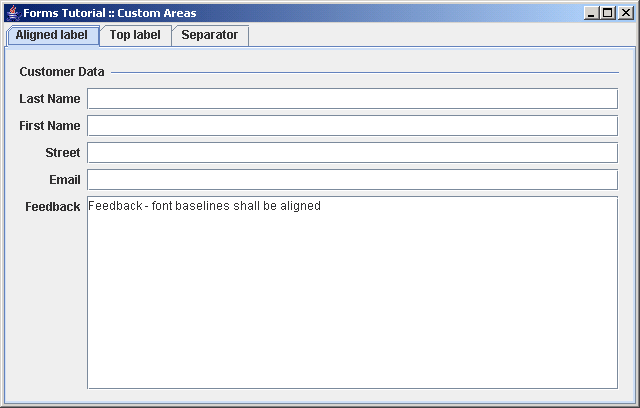Compares approaches how to append a custom area at the end of
a panel built with the DefaultFormBuilder

/*
* Copyright (c) 2002-2004 JGoodies Karsten Lentzsch. All Rights Reserved.
*
* Redistribution and use in source and binary forms, with or without
* modification, are permitted provided that the following conditions are met:
*
* o Redistributions of source code must retain the above copyright notice,
* this list of conditions and the following disclaimer.
*
* o Redistributions in binary form must reproduce the above copyright notice,
* this list of conditions and the following disclaimer in the documentation
* and/or other materials provided with the distribution.
*
* o Neither the name of JGoodies Karsten Lentzsch nor the names of
* its contributors may be used to endorse or promote products derived
* from this software without specific prior written permission.
*
* THIS SOFTWARE IS PROVIDED BY THE COPYRIGHT HOLDERS AND CONTRIBUTORS "AS IS"
* AND ANY EXPRESS OR IMPLIED WARRANTIES, INCLUDING, BUT NOT LIMITED TO,
* THE IMPLIED WARRANTIES OF MERCHANTABILITY AND FITNESS FOR A PARTICULAR
* PURPOSE ARE DISCLAIMED. IN NO EVENT SHALL THE COPYRIGHT OWNER OR
* CONTRIBUTORS BE LIABLE FOR ANY DIRECT, INDIRECT, INCIDENTAL, SPECIAL,
* EXEMPLARY, OR CONSEQUENTIAL DAMAGES (INCLUDING, BUT NOT LIMITED TO,
* PROCUREMENT OF SUBSTITUTE GOODS OR SERVICES; LOSS OF USE, DATA, OR PROFITS;
* OR BUSINESS INTERRUPTION) HOWEVER CAUSED AND ON ANY THEORY OF LIABILITY,
* WHETHER IN CONTRACT, STRICT LIABILITY, OR TORT (INCLUDING NEGLIGENCE
* OR OTHERWISE) ARISING IN ANY WAY OUT OF THE USE OF THIS SOFTWARE,
* EVEN IF ADVISED OF THE POSSIBILITY OF SUCH DAMAGE.
*/
import javax.swing.*;
import com.jgoodies.forms.builder.DefaultFormBuilder;
import com.jgoodies.forms.layout.CellConstraints;
import com.jgoodies.forms.layout.FormLayout;
import com.jgoodies.forms.layout.RowSpec;
/**
* Compares approaches how to append a custom area at the end of
* a panel built with the DefaultFormBuilder:<ol>
* <li> using two custom rows to align the leading label,
* <li> using a single custom row with label on top,
* <li> using a separator.
* </ol>
* These differ in the position of the leading 'Feedback" label,
* and in turn in the alignment of font baselines between label
* and the text area.
*
* @author Karsten Lentzsch
* @version $Revision: 1.8 $
*
* @see DefaultFormBuilder
* @see DefaultFormWithCustomRowsExample
*/
public class DefaultFormWithCustomAreasExample {
public static void main(String[] args) {
try {
UIManager.setLookAndFeel("com.jgoodies.plaf.plastic.PlasticXPLookAndFeel");
} catch (Exception e) {
// Likely PlasticXP is not in the class path; ignore.
}
JFrame frame = new JFrame();
frame.setTitle("Forms Tutorial :: Custom Areas");
frame.setDefaultCloseOperation(WindowConstants.EXIT_ON_CLOSE);
JComponent panel = new DefaultFormWithCustomAreasExample().buildPanel();
frame.getContentPane().add(panel);
frame.pack();
frame.setVisible(true);
}
// Building ***************************************************************
public JComponent buildPanel() {
JTabbedPane tabbedPane = new JTabbedPane();
tabbedPane.putClientProperty("jgoodies.noContentBorder", Boolean.TRUE);
tabbedPane.add(buildCustomAreaWithAlignedLabelPanel(), "Aligned label");
tabbedPane.add(buildCustomAreaWithTopLabelPanel(), "Top label");
tabbedPane.add(buildCustomAreaWithSeparatorPanel(), "Separator");
return tabbedPane;
}
private DefaultFormBuilder buildPanelHeader() {
FormLayout layout = new FormLayout(
"right:pref, 3dlu, min:grow",
"");
DefaultFormBuilder builder = new DefaultFormBuilder(layout);
builder.setDefaultDialogBorder();
builder.setRowGroupingEnabled(true);
builder.appendSeparator("Customer Data");
builder.append("Last Name", new JTextField());
builder.append("First Name", new JTextField());
builder.append("Street", new JTextField());
builder.append("Email", new JTextField());
return builder;
}
/**
* Demonstrates how to append a larger custom area at the end of
* a panel that is build with a {@link DefaultFormBuilder}.<p>
*
* We add a gap and a single custom row that grows and that
* is filled vertically (where the default is center vertically).
* The area uses a standard leading label.
*
* @return the custom area panel with aligned labels
*/
private JComponent buildCustomAreaWithAlignedLabelPanel() {
DefaultFormBuilder builder = buildPanelHeader();
CellConstraints cc = new CellConstraints();
builder.append("Feedback");
builder.appendRow(new RowSpec("0:grow"));
builder.add(new JScrollPane(new JTextArea("Feedback - font baselines shall be aligned")),
cc.xywh(builder.getColumn(), builder.getRow(), 1, 2, "fill, fill"));
return builder.getPanel();
}
/**
* Demonstrates how to append two custom areas at the end of
* a panel that is build with a DefaultFormBuilder.
*
* @return the custom area panel with label in the top
*/
private JComponent buildCustomAreaWithTopLabelPanel() {
DefaultFormBuilder builder = buildPanelHeader();
CellConstraints cc = new CellConstraints();
builder.appendRow(builder.getLineGapSpec());
builder.appendRow(new RowSpec("top:28dlu:grow"));
builder.nextLine(2);
builder.append("Feedback");
builder.add(new JScrollPane(new JTextArea("Feedback - likely the baselines are not aligned")),
cc.xy(builder.getColumn(), builder.getRow(), "fill, fill"));
return builder.getPanel();
}
/**
* Demonstrates how to append a larger custom area at the end of
* a panel that is build with a DefaultFormBuilder.<p>
*
* We add a gap and a single custom row that grows and that
* is filled vertically (where the default is center vertically).
* The area is separated by a titled separator and it is indented
* using an empty leading label.
*
* @return the custom area panel with separators
*/
private JComponent buildCustomAreaWithSeparatorPanel() {
DefaultFormBuilder builder = buildPanelHeader();
builder.appendSeparator("Customer Feedback");
builder.appendRow(builder.getLineGapSpec());
builder.appendRow(new RowSpec("fill:28dlu:grow"));
builder.nextLine(2);
builder.append("", new JScrollPane(new JTextArea()));
return builder.getPanel();
}
}
 forms.zip( 197 k)
forms.zip( 197 k)Related examples in the same category